Day 2 of a four day Autumn Tour in Norfolk today. It was a misty start, then cloudy for most of the day, but it stayed dry and was rather mild again for the time of year with very little wind.
Our first destination for the morning was Stiffkey Fen. As we pulled up by the road, there were several Red-legged Partridges in the field next door. As yesterday, there were Starlings on the move again today, flocks passing west overhead all day, coming in from the continent for the winter. There were Jays moving too, although these are more likely UK birds which are moving in response to a lack of acorns this autumn.
As we walked down the permissive path, we could hear Pink-footed Geese calling, but we couldn’t see them in the mist despite them being quite close. A Yellowhammer flew over. Seven Magpies came out of the copse at the end of the path (seven for a secret never to be told?).
Crossing the road, a Chiffchaff was calling in the trees down by the river. A Kestrel was perched on the gable end of the house on the hill as we came through the first kissing gate. What was presumably the same flock of Pinkfeet came back round, and now we could see them as they passed through a gap in the clouds. We could hear the distinctive ringing calls of Greenshanks coming from the Fen.
The trees alongside the river were rather quiet at first. We looked across to the Fen and couldn’t see any Spoonbills today – birds have been moving off just in the last couple of days, so perhaps the bulk of the birds which have spent the summer and bred here have finally gone south for the winter. Continuing on, we could hear Bullfinches calling ahead of us, but couldn’t see them. Almost to the seawall, we found a small group of Blue Tits in the sallows, with a Blackcap feeding on blackberries with them.
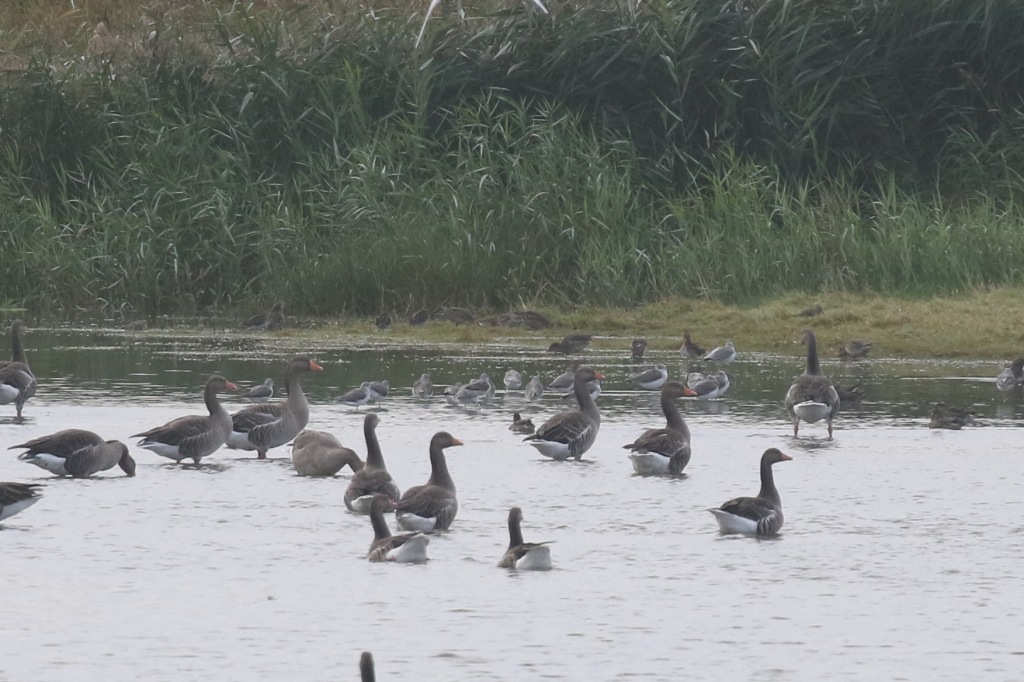
Up onto the seawall, we could see the Greenshanks roosting out on the Fen now, at least 20 of them. There were several Common Snipe on the grassy bank beyond too. In amongst the hordes of Greylag Geese, a couple of Ruff were walking round in the shallows. A large group of Black-tailed Godwits down at the front were also roosting on the Fen over high tide. A Grey Heron was stalking along the far shore.
There were lots of ducks on the Fen too, mainly Wigeon and Teal, plus a few Mallard and one or two Shoveler. We eventually found a single Pintail. A huge flock of geese flew in from the fields behind – we could hear one or two higher pitched yelping calls of Pink-footed Geese with them, but mainly the lower honking of Greylags. There were enough on the Fen already, but the others dropped in too. The Pink-footed Geese flew on.
A flock of Long-tailed Tits came across the reedbed into the bushes. They have been in short supply this autumn, probably the result of a poor breeding season, so it is nice to see there is a flock here. A single Chiffchaff came through with them.
There are big spring tides at the moment and the tide was just starting to go out in the harbour. We could see a variety of birds out on the water in the Pit – a single Red-breasted Merganser, three Red-throated Divers, a Guillemot, a Great Crested Grebe. The water was running fast and the birds were carried quickly with it, so much so that the Guillemot spent most of the time going rapidly backwards!
There were a few gulls over the harbour entrance and we picked up five distant Little Gulls over the sandbar with them. We could see a few Grey Seals out on Blakeney Point too. A big flock of Golden Plover came up over the saltmarsh away to west and an even bigger flock circled over the fields well inland.
As we walked round to the harbour, a Reed Bunting flew over the channel, the first we have seen on this trip. The first of the mud was just starting to appear, and a couple of Brent Geese were feeding just across the channel. There was a good selection of waders here too – lots of Dunlin, a few Ringed Plover and Turnstone, Redshanks, Grey Plover and Curlew. The Oystercatchers had been roosting on the Point and started to fly out in long lines as the sandbars emerged from the water in the middle of the Pit.
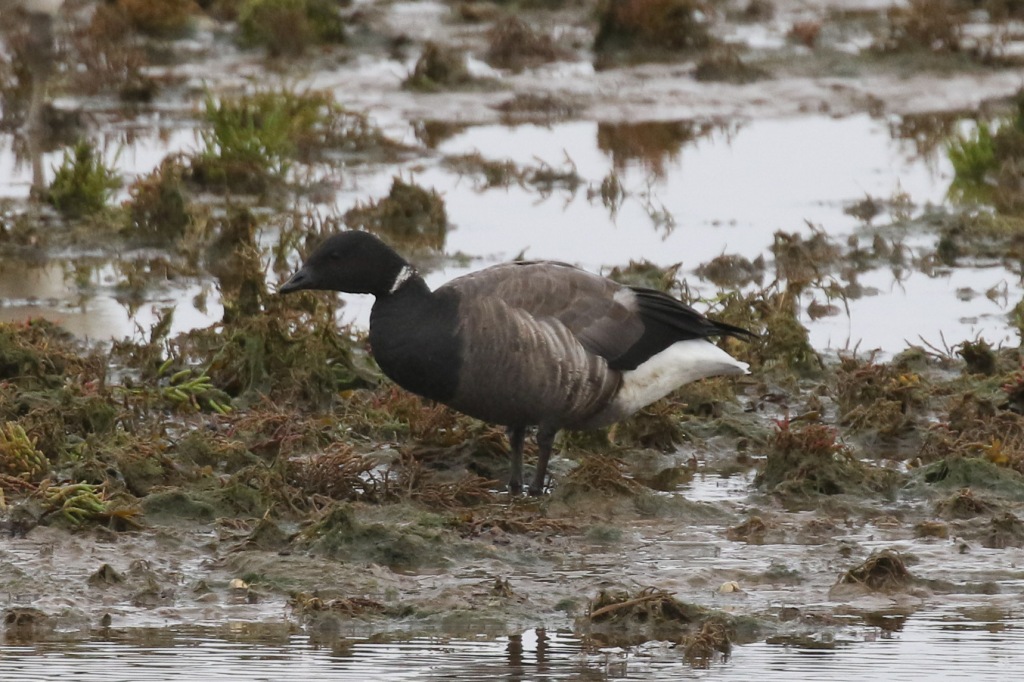
There were lots of gulls in the harbour too, and we got the scopes on a Common Gull in with the Black-headed Gulls at the front to have a closer look at the differences between them at this time of year.
There were a few small birds around the bushes just across the channel. A flock of Linnets kept flying up and a couple of Reed Buntings perched up with them. There were several Pied Wagtails and Meadow Pipits too. A Rock Pipit landed briefly on the stern of one of the boats in the channel, but was quickly chased off by a Pied Wagtail. Scanning the saltmarsh behind us, a couple of Stonechats were perching on the tops of the Suaeda. A Stock Dove flew in over the harbour.
On the walk back, the only other addition to the list was a Sparrowhawk which circled over the copse by the permissive path. We headed on east, with a quick stop at Cley en route to use the facilities, then on to Walsey Hills. As we got out of the minibus, we could see two large white birds roosting out on Pope’s Pool – two Spoonbills. Despite the bulk of the birds which spent the summer here having left now, there are a few lingering still along the coast. We had a quick look through the scope from here in case they flew off before we got out onto the East Bank.
First, we had a quick walk down the footpath in to the bushes, to see if there were any migrants arriving. There were lots of the resident birds around the feeders, Blue and Great Tits, several Greenfinches and Goldfinches. We could hear another Chiffchaff calling and even a quick burst of song.
As we got down to the far end, we could hear the distinctive call of a Yellow-browed Warbler. It was deep in the willows at the back, so we carried on out into the open and looked back along the far edge. We couldn’t see anything moving and as we had seen one yesterday, we decided not to spend too long trying to get more views. A Great Spotted Woodpecker called from the wood beyond. As we walked back through the bushes, a couple of Blackbirds in the bushes may have been new arrivals. We stopped to see if anything was with them and a Redwing flew over.
Back out to the road, we walked on to the East Bank. It was a nice morning now and quite still, but although we could hear Bearded Tits calling from the reeds, there was no sign of any up in the tops. A Water Rail squealing from the ditch was keeping typically well hidden.
Up to the Serpentine, we got the scopes out for a closer look at the Spoonbills. They were typically asleep, but one did wake up for a preen at one point, flashing its plain fleshy-coloured bill and stretching its black-tipped wings, showing it to be one of this year’s juveniles.
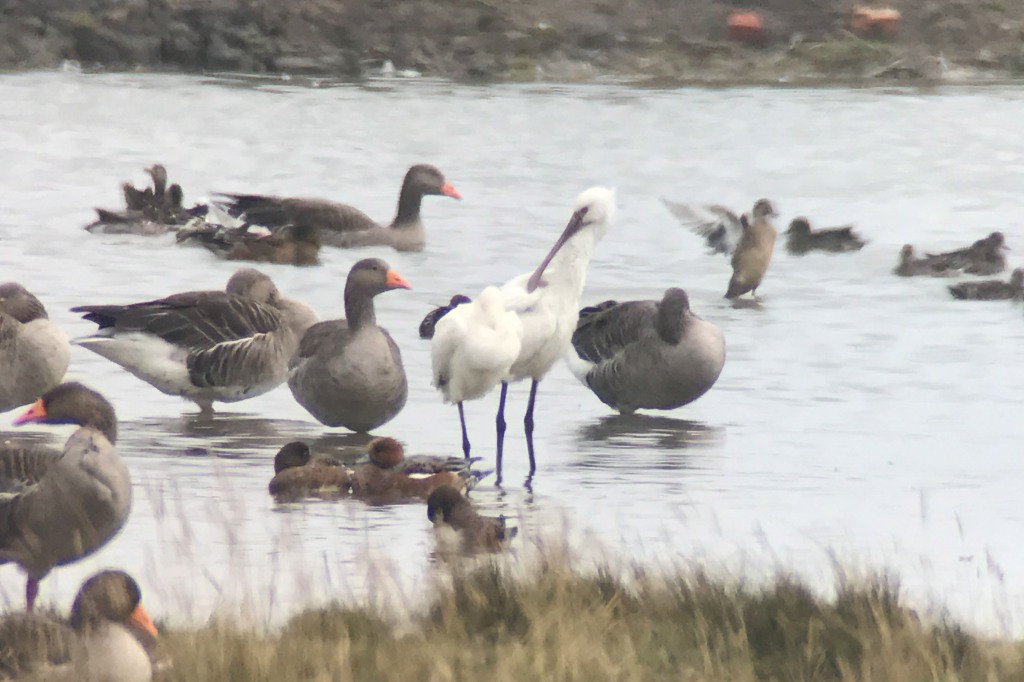
There were lots of geese and ducks on Pope’s Pool too. The geese were predominantly Greylags, but three Barnacle Geese were asleep in the grass just in front, presumably birds from the ever-expanding UK feral population. Two Marsh Harriers circled round over the reedbed beyond.
Continuing on to Arnold’s Marsh, the water level has risen, presumably as seawater has leached through the shingle on the recent big high tides. Three Avocets were the highlight on here, asleep on the shingle ridges on the far edge, with a single Grey Plover nearby. There were lots of Common Redshanks and Black-tailed Godwits at back. Several Meadow Pipits kept flicking up from the saltmarsh. A quick scan of the brackish pools behind produced two Little Grebes and a single Pintail.
On to the beach, the sea was flat calm like a millpond today, although there was still some mist hanging offshore. There were lots of birds on the water – rafts of auks, particularly Razorbills and smaller numbers of Guillemots diving offshore; several Red-throated Divers, one or two close in, still in breeding plumage; a couple of Great Crested Grebes.
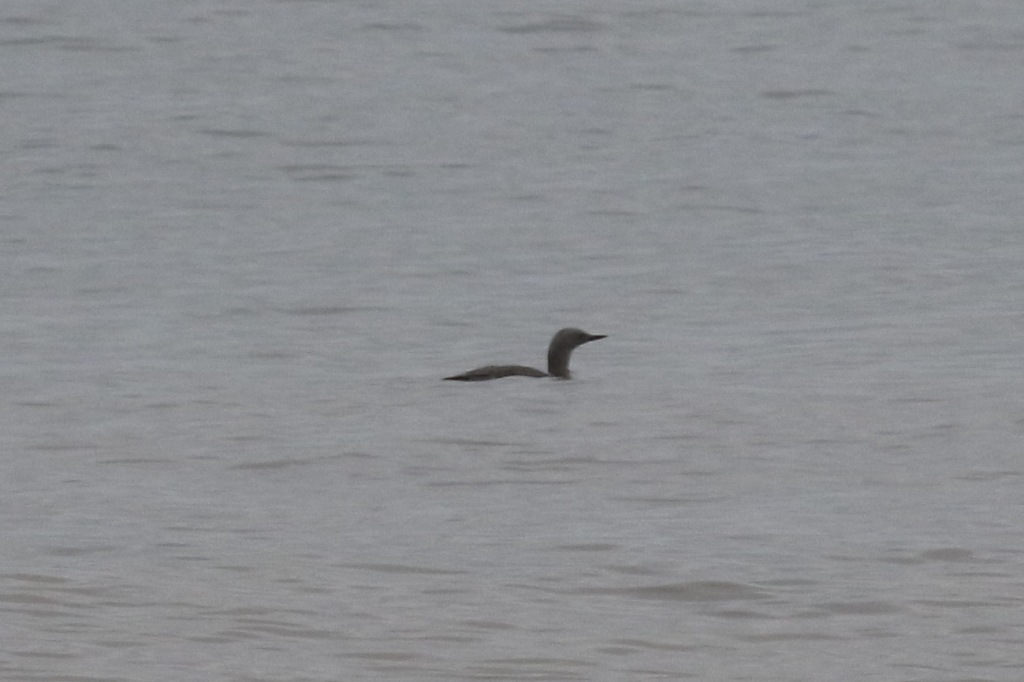
Further back, a small group of Gannets were feeding from the surface rather than plunge diving. They were accompanied by several auks and the inevitable large gulls hanging around trying to nick some scraps, making a small feeding frenzy. A few Little Gulls were patrolling up and down, dip feeding, and a single juvenile Common Tern flew past. Two Kittiwakes were swimming nearby. We picked up a distant Manx Shearwater flying very low over the surface of the sea, but it landed and was lost to view in the mist.
There were small numbers of wildfowl moving offshore today. Two drake Eider flew past, and a couple of small groups of Common Scoter. There were also a few Brent Geese and Teal coming in from the continent. A single Pink-footed Goose swimming out on the sea looked decidedly out of place!
We were distracted for some time by all the action out on the beach, so it was already time for lunch. We made our way back to the minibus, and drove back round to the Visitor Centre to get a hot drink and use the picnic tables overlooking the reserve. There was a Snow Bunting reported as being “on the beach” on the sightings board in the Visitor Centre, but the staff there had no idea where. We hadn’t seen it out by the East Bank earlier, so we thought it might be somewhere between the beach car park and North Scrape.
So after lunch, we drove out to the beach car park. There were a few people looking out to sea here so we joined them for another scan. It was similar here to what we had seen off the East Bank earlier – although with more Little Gulls, several dip feeding around another Gannet feeding frenzy which made them a bit easier for everyone to get onto. A couple of adult Mediterranean Gulls were out on the sea too. Looking through the auks and divers, we found a single Tufted Duck on the water as well.
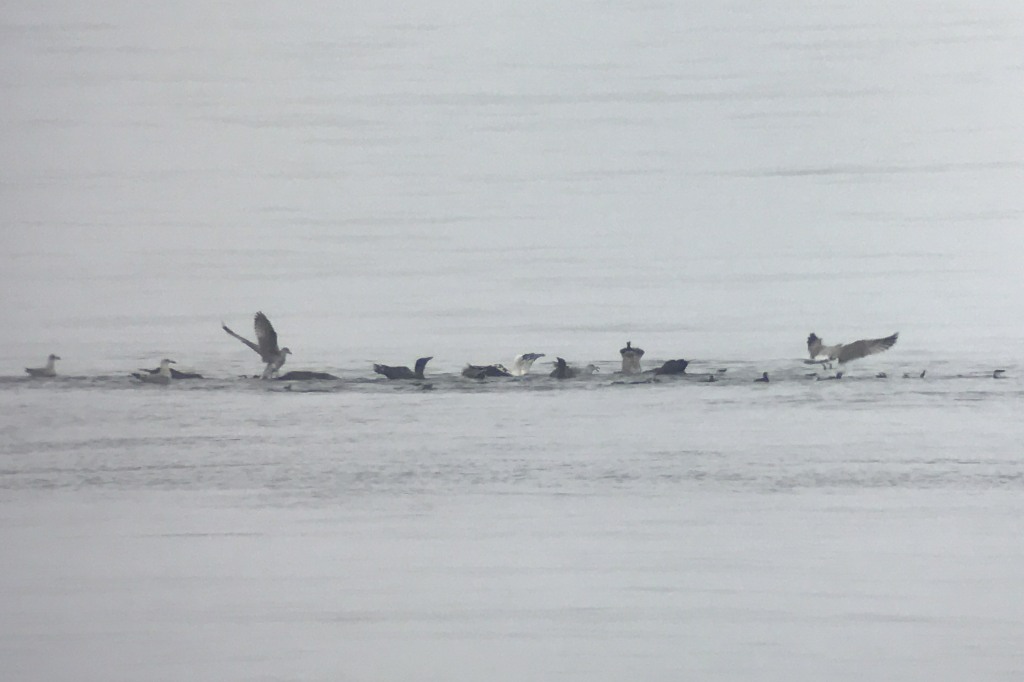
We walked a short way east over the shingle to see if we could find any Snow Buntings but drew a blank. We thought we might get lucky and find some other migrants fresh in or moving along the coast, but all we came across was a single Blackbird which flushed out of the grass on the beach, presumably a migrant.
We cut across from the beach to the path and stopped to scan North Scrape from the high point of the Eye Field. There were lots of Pink-footed Geese loafing out on the scrape, with more flying in from the west and dropping in to join them all the time. There were lots of ducks too, though nothing we hadn’t seen before, three more Pintail the highlight. A big flock of Goldfinches was feeding in the vegetation on the beach behind North Screen.
We drove back west to Stiffkey for the remainder of the afternoon. We scanned the saltmarsh from the high point just beyond the car park but all we managed to pick up from here was a distant Marsh Harrier. There were several Curlews and Little Egrets out on the saltmarsh.
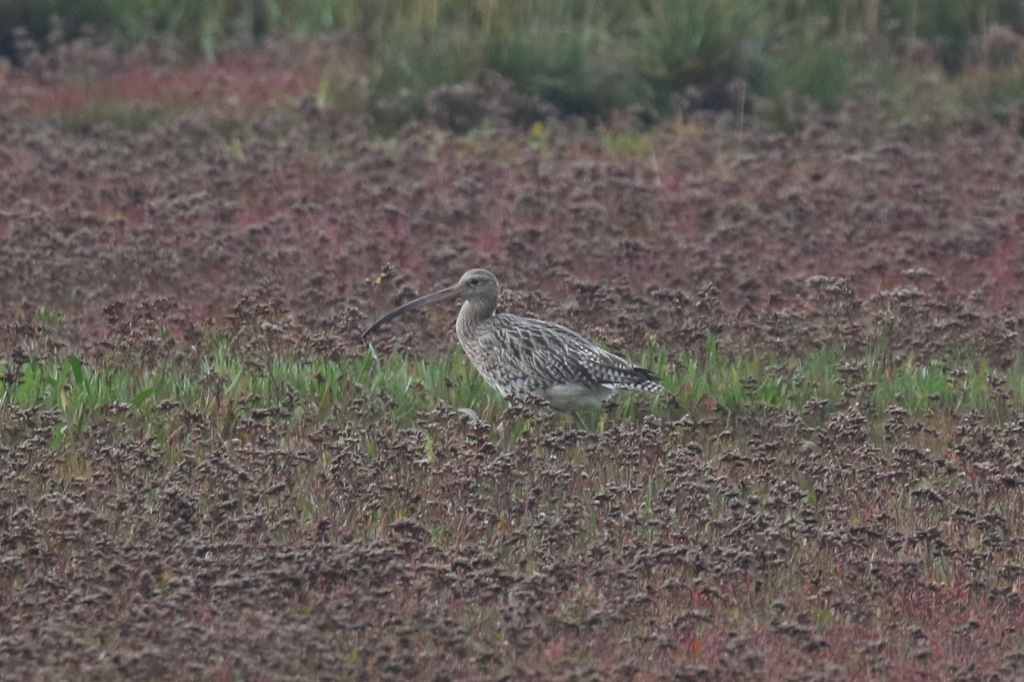
We hoped there might be some migrants feeding in the bushes by the coast path, or at least some lingering sylvia warblers, but as we walked west out to the Whirligig it was all disappointingly quiet. We stopped to scan again from the edge of the circular path. There were lots of Black-headed Gulls commuting between the saltmarsh and the field just inland which a tractor was cultivating. Otherwise, there were more Curlews and Redshanks.
It was still a bit early for birds coming in to roost, but we hoped we might find some raptors out hunting here already. We could see two Marsh Harriers out over the back of the saltmarsh now. A Kestrel dropped in to the bushes, then flew over and started hovering right behind us. But nothing else in yet.
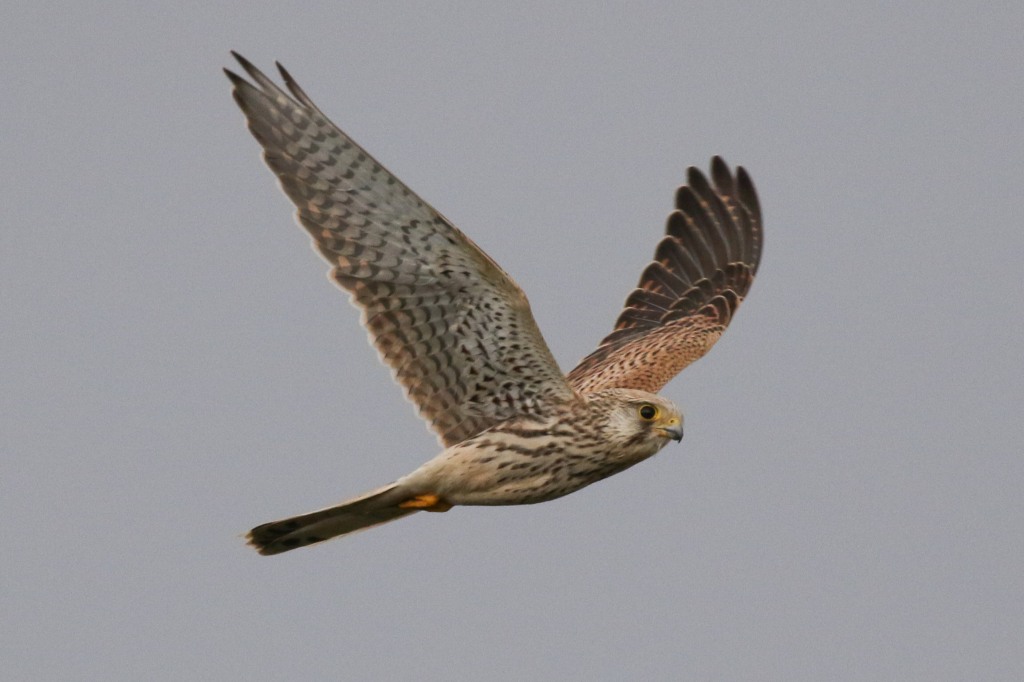
It was time to head back. Three Egyptian Geese flew past as we walked back. We had another two day’s birding to look forward to.
















